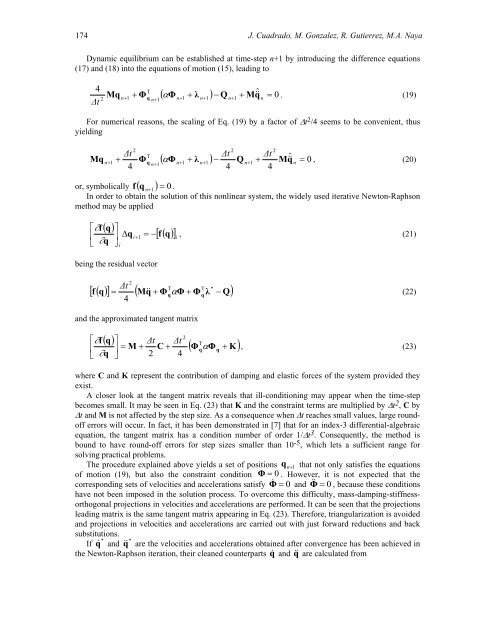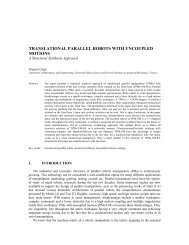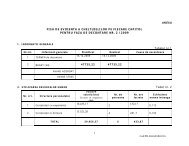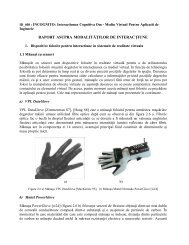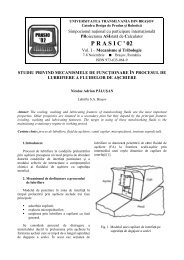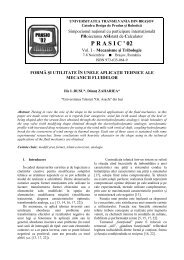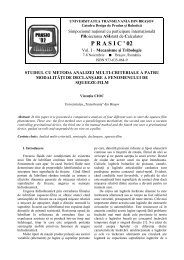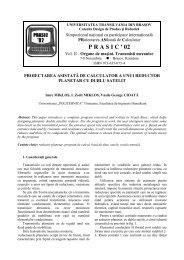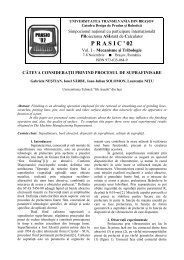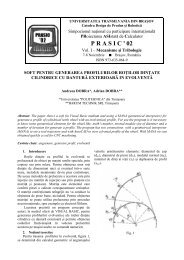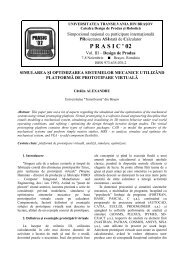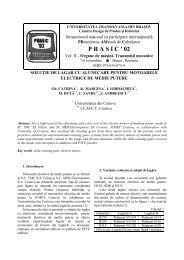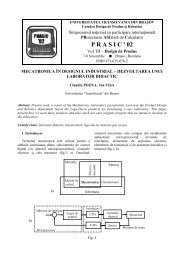real-time mbs formulations: towards virtual engineering
real-time mbs formulations: towards virtual engineering
real-time mbs formulations: towards virtual engineering
Create successful ePaper yourself
Turn your PDF publications into a flip-book with our unique Google optimized e-Paper software.
174 J. Cuadrado, M. Gonzalez, R. Gutierrez, M.A. Naya<br />
Dynamic equilibrium can be established at <strong>time</strong>-step n+1 by introducing the difference equations<br />
(17) and (18) into the equations of motion (15), leading to<br />
4<br />
∆t<br />
( Φ + λ ) − Q + Mq&<br />
ˆ 0<br />
T<br />
2 n+ 1<br />
+ Φ<br />
1 + 1 + 1 + 1<br />
=<br />
n+<br />
n n n<br />
n<br />
Mq &<br />
q<br />
α . (19)<br />
For numerical reasons, the scaling of Eq. (19) by a factor of ∆t 2 /4 seems to be convenient, thus<br />
yielding<br />
2<br />
2<br />
2<br />
∆t T<br />
∆t ∆t<br />
Mq ( ) ˆ<br />
n+ 1<br />
+ Φq α Φ<br />
1<br />
+<br />
1<br />
−<br />
1<br />
+ = 0<br />
n+<br />
1 n+<br />
λ<br />
n+<br />
Q<br />
n+<br />
Mq&<br />
n<br />
, (20)<br />
4<br />
4 4<br />
or, symbolically f ( q n+1<br />
) = 0 .<br />
In order to obtain the solution of this nonlinear system, the widely used iterative Newton-Raphson<br />
method may be applied<br />
( q)<br />
⎡∂f<br />
⎢<br />
⎣ ∂q<br />
⎤<br />
⎥ ∆q<br />
⎦<br />
i<br />
i +1<br />
= −<br />
being the residual vector<br />
[ f ( q)<br />
] i<br />
, (21)<br />
2<br />
∆t<br />
T<br />
T *<br />
[ f ( q)<br />
] = ( Mq&&<br />
+ Φ αΦ<br />
+ Φ λ − Q)<br />
4<br />
q<br />
q<br />
(22)<br />
and the approximated tangent matrix<br />
⎡∂f<br />
⎢<br />
⎣ ∂q<br />
2<br />
( q) ⎤ ∆t ∆t T<br />
= M + C + ( Φ αΦ<br />
K)<br />
⎥<br />
⎦<br />
2<br />
4<br />
q q<br />
+<br />
, (23)<br />
where C and K represent the contribution of damping and elastic forces of the system provided they<br />
exist.<br />
A closer look at the tangent matrix reveals that ill-conditioning may appear when the <strong>time</strong>-step<br />
becomes small. It may be seen in Eq. (23) that K and the constraint terms are multiplied by ∆t 2 , C by<br />
∆t and M is not affected by the step size. As a consequence when ∆t reaches small values, large roundoff<br />
errors will occur. In fact, it has been demonstrated in [7] that for an index-3 differential-algebraic<br />
equation, the tangent matrix has a condition number of order 1/∆t 3 . Consequently, the method is<br />
bound to have round-off errors for step sizes smaller than 10 -5 , which lets a sufficient range for<br />
solving practical problems.<br />
The procedure explained above yields a set of positions q<br />
n+ 1 that not only satisfies the equations<br />
of motion (19), but also the constraint condition Φ = 0 . However, it is not expected that the<br />
corresponding sets of velocities and accelerations satisfy Φ & = 0 and Φ &<br />
= 0 , because these conditions<br />
have not been imposed in the solution process. To overcome this difficulty, mass-damping-stiffnessorthogonal<br />
projections in velocities and accelerations are performed. It can be seen that the projections<br />
leading matrix is the same tangent matrix appearing in Eq. (23). Therefore, triangularization is avoided<br />
and projections in velocities and accelerations are carried out with just forward reductions and back<br />
substitutions.<br />
*<br />
If q& and q& & * are the velocities and accelerations obtained after convergence has been achieved in<br />
the Newton-Raphson iteration, their cleaned counterparts q& and q& & are calculated from


